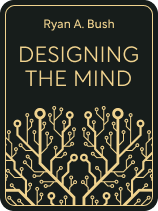

This article is an excerpt from the Shortform book guide to "Designing the Mind" by Designing the Mind and Ryan A Bush. Shortform has the world's best summaries and analyses of books you should be reading.
Like this article? Sign up for a free trial here.
Do you want to become the master of your own mind? Do you struggle with thoughts, emotions, and behaviors that don’t align with your goals and aspirations?
If so, Ryan A. Bush’s book Designing the Mind can help. Bush argues that the mind is like a computer that can be reprogrammed, and he provides a collection of strategies that will help you change the thought patterns, emotions, and behaviors that are holding you back into ones that help you become your best self.
Below is a brief overview of Designing the Mind by Ryan A. Bush.
Designing the Mind
In the Designing the Mind book, Ryan A. Bush argues that your thought patterns and emotional responses aren’t static, as many people believe—in reality, you can “reprogram” your mind like a computer to create new, more favorable patterns of thinking.
Bush is a designer whose work centers on creating a better future by improving systems and people. He’s worked in systems design for tech startups, creating everything from software to buildings, and he continues to pursue a lifelong passion for self-optimization. He created Designing the Mind, a self-development organization, to share knowledge from philosophy and psychology that people can use to take control of their minds. His other projects include Mindform, an online community and training platform with the same mission as Designing the Mind, and The Anxiety Algorithm, a 30-day program that helps you change your relationship with anxiety and stress.
In our guide, we’ll discuss:
- Bush’s assertion that the mind is like a computer with software that can be adjusted to better suit your needs
- How to rewrite faulty thought patterns
- How to get rid of emotions that don’t serve you
- How to change your behavior so it aligns with your goals and values
(Shortform note: The author organizes the information in Designing the Mind into three “realms,” which we’ll refer to as levels in this guide: cognitive, emotional, and behavioral. This is arguably effective because each level builds on the previous one’s skills, creating a smooth progression from mental mastery, to emotional mastery, and, finally, to behavioral mastery.)
Our commentary will explore alternative methods for changing unwanted thought patterns, emotions, and behaviors. It’ll also provide a deeper look into some of the neurological and psychological phenomena behind Bush’s arguments.
Background: Rewriting Your Mental Programs
According to Bush, you don’t have to accept your default mental processes as your unchanging reality—to be your best self, you shouldn’t. In this section, you’ll learn how you can shape your mind by treating your thought processes like computer algorithms that can be edited. We’ll also discuss how the brain is built to adapt and change, making this kind of conscious modification possible.
The Mind as a Computer
Bush argues that the mind is like a computer, with immeasurable inputs and algorithms that prompt the behaviors that make us who we are.
In our minds, inputs are external stimuli—for instance, things we see, hear, or experience—that come from events in our daily lives. These inputs then trigger our “mental algorithms,” or thought patterns, which lead to outputs in the form of our feelings and actions.
Sometimes, our default thought patterns don’t serve us. They might be linked to biases and faulty assumptions that prompt undesirable emotions and behaviors, leading us to act counterproductively to our values and goals. Bush asserts, however, that you don’t have to maintain faulty thought patterns forever—since the mind functions like a computer, with the proper knowledge, you can alter your brain’s algorithms like an engineer designing computer software. When you learn to modify your mental algorithms, you can better control the nature of your outputs.
The Malleable Nature of the Brain
Scientifically speaking, how is it possible for us to make the large-scale changes to our minds that Bush recommends? Bush argues that the brain’s malleability—which neuroscientists call neuroplasticity—has evolutionary roots. Our ancestors frequently had to adapt to changing conditions, so their brains also had to restructure and adjust to support their survival. Even today, by default, we’re constantly creating new neural pathways through our experiences—pathways that are strengthened or weakened as we learn and practice different thought processes and behaviors.
To modify your mind and harness neuroplasticity with intention, Bush notes, start by studying your current thought patterns. What kind of judgments do you make about different situations, places, and people? Consider your mental processes like an outside observer, with the recognition that they don’t represent objective truth. This exercise is called metacognition, or developing an awareness and understanding of your own thought processes.
Mindfulness practices like breath-focused meditation can be a great starting point for developing metacognition since they allow you to pay attention to your thoughts and feelings without judgment.
In the rest of this guide, we’ll discuss specific strategies you can use to rewrite your default programming on three levels: thought patterns, emotional responses, and behaviors.
Level 1: Adjusting Your Thought Patterns
According to Bush, the first level of mental programming you need to address to become your ideal self is your thought patterns and beliefs. Having faulty beliefs will make it difficult to master the other aspects of your mind because your choices, feelings, and behaviors all stem from what you believe.
In this section, you’ll learn how biases and the false beliefs they can trigger harmfully distort your thinking patterns, as well as how to rewrite your biased thoughts into more beneficial patterns.
The Problem With Biases and False Beliefs
The author asserts that the ultimate goal of improving your thought patterns is to develop a perception of reality that’s as close to the truth as possible. One of the main challenges to achieving this goal is the prevalence of cognitive biases that distort our beliefs and perceptions. Cognitive biases are snap judgments we make about ourselves, others, and the world around us that are often based on false premises.
In basic terms, a biased thinking process looks like this: We receive some type of input, and instead of this prompting an accurate thought pattern, our thoughts in response to the input are distorted by a bias. The distorted thought pattern then leads to false beliefs and unfavorable actions based on those false beliefs. False beliefs can be highly problematic, especially when we have a lot of them that link together into a belief system that distorts our entire worldview.
For example, racial biases—assumptions about groups of people based on their race or ethnicity—lead to discriminatory behavior and inequalities. These faulty thought patterns shape people’s views of how others should be treated. The patterns allow people to justify harmful actions and inequities they would otherwise condemn because they believe the racial group they’re biased against somehow deserves the poor treatment.
Why Do Biases Exist?
Though they often get us into trouble, biases are likely so prevalent because they conserve energy. Our brains are confronted with a constant flow of information and choices, and it would be overwhelming and fatiguing to thoroughly process them all. Biases save us energy by prompting snap judgments about people, places, and things—even if they’re often inaccurate. These faulty assumptions are then integrated into our belief systems and thought patterns, leading us to rely on the same incorrect biases again and again.
How to Overcome Your Biases
According to Bush, to more accurately perceive reality, you need to actively work to eliminate your biases. This can be a difficult process because we typically struggle to see our own biases, even when we can recognize them in other people. Despite this, it’s possible with study and practice.
Let’s explore three ways to overcome biases: through mindfulness, self-study, and reflection.
Practice #1: Use Mindfulness to Overcome Biases
As we mentioned earlier, mindfulness practice can be a good way to start building awareness of your cognitive processes, including your biases. According to Bush, it allows you to focus your attention on patterns of thinking that would otherwise be automatic.
Practice #2: Use Self-Study to Overcome Biases
Bush also advises learning about the most common biases so you can begin recognizing them in yourself. Study them using multiple sources, and familiarize yourself with the situations that normally trigger them.
Practice #3: Use Reflection to Overcome Biases
Once you identify a bias you have, Bush advises trying to notice every situation that triggers it. Instead of acting based on your biased thinking, pause to reflect. Consciously create an alternative, unbiased thought pattern and act based on this new pattern. The more often you do this for the same type of situation, the more intuitive your new thought pattern will become. Eventually, it’ll replace the biased thought pattern entirely.
Bias Example: Rewriting Confirmation Bias
As Bush mentions, one well-known and universal cognitive bias is confirmation bias. When under its influence, we place a disproportionately high value and strong focus on information that confirms our existing beliefs while ignoring or denying information that contradicts those beliefs. An example of a triggering situation for confirmation bias might be reading an article that represents an opposing opinion on a political issue that’s important to you: You might immediately dismiss it as illogical, irrelevant, or further confirmation that the other side doesn’t know what they’re talking about.
Confirmation bias can limit your exposure to new information and ideas, preventing important growth and change. Therefore, it’s useful to identify and reduce this bias in yourself.
Level 2: Conquering Your Emotions
The next level of mental programming Bush suggests you work on is conquering your emotions. He argues that understanding and altering your emotional responses must come next because emotions, more than anything else, drive us to act. If you have a poor emotional reaction to a situation, then your behavioral response will likely do more harm than good. (For example, most of us have said or done something in anger that we regretted once we calmed down.) If you learn to modulate your emotional responses, you can more easily change your behavior for the better.
In this section, we’ll discuss where our emotions come from. We’ll also explore Bush’s method of using rational thinking to get rid of undesirable emotions.
Where Our Emotional Responses Come From
To begin controlling your emotions, Bush notes, you have to first understand how they form. Your rational thought processes mediate your emotional responses: Instead of responding with an emotion directly after you experience a stimulus (like an interaction with another person or a piece of news you receive), there’s a thought pattern in between the two that determines how you feel about the stimulus. Usually, if you judge that the outcome of the stimulus is desirable, you’ll experience positive emotions. If you judge that the outcome isn’t what you wanted, you’ll experience negative emotions.
How to Change Your Emotional Responses
Bush states that you can change your emotional responses by reevaluating how you think about situations that cause undesirable emotions. Start by keeping a log of every undesirable emotion you experience. As you name each emotion, also write down the situation that triggered it and any thoughts you had before you felt it.
Over time, Bush notes, you’ll start to see patterns in the kinds of situations and lines of reasoning that lead to negative emotions: For instance, maybe almost every time you feel sadness, the emotion is preceded by self-deprecating thoughts. Once you’ve identified some of your patterns, you can start to rewrite them. Analyze the faulty thoughts and beliefs that lead to each undesirable emotion and come up with rebuttals for them. This will prevent the undesirable emotion from triggering. As you practice identifying and challenging the reasoning behind undesirable emotions, you’ll get better at moving past them.
Level 3: Mastering Your Behavior
In the previous two sections, you learned how to change faulty, bias-driven thought patterns and get rid of unhelpful emotions. In this section, you’ll learn how to implement Bush’s final level of self-mastery: control over your behavior and actions. We’ll examine his assertion that you should direct your behavior toward values-based goals, along with his strategies for changing your behavioral habits.
Self-Control and Following Your Goals
According to Bush, you should strive to gain as much control over your behavior and actions as possible. People who have a high level of self-control experience a collection of benefits, including a healthier lifestyle, more stable finances, more successful relationships, and a generally better state of mental and physical health.
Base Goals On Your Values
To reach a successful state, you have to specifically direct your behavior toward achieving your goals. Bush argues you should base your goals on your values.
Before we explain how to set values-based goals, let’s explore what values actually are. Values start as your intuitions about the perceived “goodness” and “badness” of different actions and consequences. When you have the same intuitions about what’s good and bad over and over, you get a sense of your ideal traits, such as kindness, courage, or honesty. The collection of these ideals becomes your value system, which represents your ideal self and the traits you want to embody. Embodying your values will bring you fulfillment and success.
Values vs. Desires
Bush warns that values shouldn’t be confused with desires. Desires represent the things we want and crave—like a fancy new phone or expensive concert tickets—but they aren’t necessarily the things that will make us happy. Often, when we acquire the object of our desire, it doesn’t make us feel as good as we thought it would, leaving us unsatisfied. Desires also invite loss into our lives—we feel good when we obtain something we want, but we suffer when we inevitably lose it since everything’s impermanent.
Even though they rarely contribute to our long-term happiness, Bush notes, desires are often more powerful than values. Our brains are designed to follow desires without question—the feel-good chemical dopamine (which is tied to desire) pushes us toward action with the promise that we’ll receive a reward once we get what we want. In contrast, values are steady and ever-present, but they’re also easier to ignore.
How to Set Values-Based Goals
Bush describes a values-oriented framework you can use to design your goals. As representatives of your ideal self, your values should be at the top of your goal framework, meaning that your goals should always bring you closer to them in some way. Then, use reason and logic to determine the best methods for achieving those goals. Finally, let your desires drive you to take action toward your goals.
For example, say you strongly value independence. To become closer to your ideal self as an independent person, you make a lofty, value-driven goal to be your own boss someday. Instead of quitting your job right away, though, you use logic to make a plan that will allow you to save enough money to open a business of your own. Finally, you allow your desires—like wanting comfort and security, wanting a flexible schedule, and so on—to push you to take the steps necessary to make the plan a success.
How to Change Your Habits
Along with aligning your behavior toward values-based goals, Bush asserts that eliminating and replacing bad habits is another way to take control of your behavior. Good habits are behavioral patterns that push you toward your goals, while bad ones take you away from your goals.
Bush describes two strategies you can use to redirect your behavior and form more beneficial habits:
Strategy #1: Keep Track of Your Habits
According to Bush, just keeping track of your habits can sometimes be enough to break bad ones. To change your behavior, you have to first understand and analyze your current patterns, which this strategy promotes.
Start by writing a list of habits you want to have and habits you don’t want. For example, maybe you want to cook five nights a week and take your dog for a walk every morning, but you also want to stop biting your nails and procrastinating on your email responses. Once you have your list, keep a record of how many times you do each habitual behavior per week. You’ll see how much of a hold bad habits have on your time, and you can then take the steps necessary to break them.
Strategy #2: State How You Plan to Spend Your Time in Advance
According to Bush, you can create a new, positive habit by setting clear intentions and goals for enacting it. We’re often too vague when trying to implement a new behavior—without a specific plan, we’re much less likely to follow through. This is because we have to use more willpower and make more decisions when the time comes for us to actually engage in the new behavior. If you have a plan beforehand, that mental work is already done for you.
When planning a new habit, express the following in specific terms:
- The behavior you want to implement
- The exact time and day you’ll implement it
- The location where you’ll implement it
For example, instead of saying to yourself, “I want to walk my dog more,” say “I want to take my dog for a half-hour-long walk every morning at 7:00 am in the park.”

———End of Preview———
Like what you just read? Read the rest of the world's best book summary and analysis of Designing the Mind and Ryan A Bush's "Designing the Mind" at Shortform.
Here's what you'll find in our full Designing the Mind summary:
- How the mind can be reprogrammed like a computer
- Strategies to help you change negative thought patterns, emotions, and behaviors
- How to eliminate your biases to perceive reality more accurately






